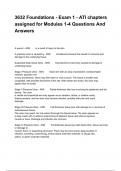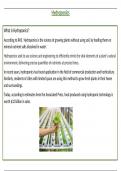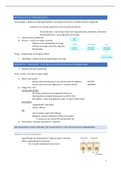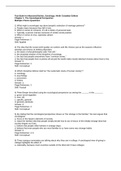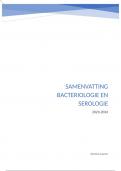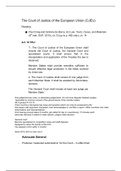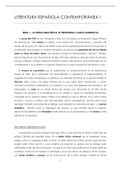3632 Foundations - Exam 1 - ATI chapters
assigned for Modules 1-4 Questions And
Answers
A wound - ANS Is a result of injury to the skin
A pressure ulcer is caused by - ANS Unrelieved pressure that results in ischemia and
damage to the underlying tissue
Suspected deep tissue injury - ANS Discolored but intact skin caused by damage to
underlying tissue
Stage I Pressure Ulcer - ANS Intact skin with an area of persistent, nonblanchable
redness, typically over
a bony prominence, which may feel warm or cool to touch. The tissue is swollen and
congested, with possible discomfort at the site. With darker skin tones, the ulcer may
appear blue or purple.
Stage II Pressure Ulcer - ANS Partial-thickness skin loss involving the epidermis and the
dermis. The ulcer
is visible and superficial and may appear as an abrasion, blister, or shallow cavity.
Edema persists, and the ulcer may become infected, possibly with pain and scant
drainage.
Stage III Pressure Ulcer - ANS Full-thickness tissue loss with damage to or necrosis of
subcutaneous tissue.
The ulcer may reach, but not extend thorough the fascia below. The ulcer appears as
a deep crater with or without undermining of adjacent tissue and without exposed
muscle or bone. Drainage and infection are common
Stage IV Pressure Ulcer - ANS Full-thickness tissue loss with destruction, tissue necrosis,
or damage to
muscle, bone, or supporting structures. There may be sinus tracts, deep pockets of
infection, tunneling, undermining, eschar (black scab-like material), or slough (tan,
yellow, or green scab-like material).
,Unstageable Pressure Ulcer - ANS Ulcers whose stages cannot be determined because
eschar or slough
obscures the wound.
Intact skin with an area of persistent, nonblanchable redness - ANS Stage I
may feel warm or cool to touch - ANS Stage I
The tissue is swollen and
congested - ANS Stage I
Possible discomfort at the site. - ANS Stage I
darker skin tones, may appear blue or purple - ANS stage I
Partial-thickness skin loss involving the epidermis and the dermis - ANS Stage II
is visible and superficial and may appear as an abrasion, blister, or shallow cavity - ANS
Stage II
Edema persists - ANS Stage II
possibly with pain and scant
drainage - ANS Stage II
Full-thickness tissue loss with damage to or necrosis of subcutaneous tissue - ANS Stage
III
may reach, but not extend thorough the fascia below - ANS Stage III
appears as
a deep crater with or without undermining of adjacent tissue and without exposed
muscle or bone - ANS Stage III
Drainage and infection are common - ANS Stage III
Full-thickness tissue loss with destruction, tissue necrosis, or damage to
muscle, bone, or supporting structures - ANS Stage IV
be sinus tracts, deep pockets of
infection, tunneling, undermining, eschar, or slough. - ANS Stage IV
Eschar - ANS Black scab-like material
,Slough - ANS Tan, yellow, or green scab like material.
The Stages of Wound Healing - ANS 1. Inflammatory stage
2. Proliferative stage
3. The maturation or remodeling stage.
The inflammatory stage - ANS occurs in the first 3 days after the initial trauma
Control bleeding with clot formation - ANS The inflammatory stage
Deliver oxygen, WBC, and nutrients to the area via the blood supply - ANS The
inflammatory stage
The proliferative stage - ANS lasts the next 3 to 24 days
Replacing lost tissue with connective or granulated tissue - ANS The proliferative stage
Contraction of the wound's edges - ANS The proliferative stage
Resurfacing of new epithelial cells - ANS The proliferative stage
Maturation or remodeling stage i - ANS strengthening of the collagen scar
and the restoration of a more normal appearance. It can take more than 1 year to
complete, depending on the extent of the original wound.
Primary intention - ANS Little or no tissue loss
Edges are approximated, as
with a surgical incision
• Heals rapidly
• Low risk of infection
• Minimal or no scarring
Secondary intention - ANS • Loss of tissue
• Wound edges widely
separated, as with pressure
ulcers and stab wounds
• Increased risk of infection
• Scarring
Tertiary intention - ANS • Widely separated
• Deep
• Spontaneous opening of a
previously closed wound
, • Risk of infection
• Extensive drainage and tissue
debris
• Closes later
• Long healing time
Little or no tissue loss - ANS Primary intention
Edges are approximated, as
with a surgical incision - ANS Primary intention
Heals rapidly - ANS Primary intention
Low risk of infection - ANS Primary intention
Minimal or no scarring - ANS Primary intention
Increased risk of infection - ANS Secondary intention
Scarring - ANS Secondary intention
Loss of tissue - ANS Secondary intention
Wound edges widely
separated, as with pressure
ulcers and stab wounds - ANS Secondary intention
Widely separated - ANS Tertiary intention
Deep - ANS Tertiary intention
Spontaneous opening of a
previously closed wound - ANS Tertiary intention
Risk of infection - ANS Tertiary intention
Extensive drainage and tissue
debris - ANS Tertiary intention
Closes later - ANS Tertiary intention
Long healing time - ANS Tertiary intention
Serous drainage - ANS is the portion of the blood (serum) that is watery and clear

